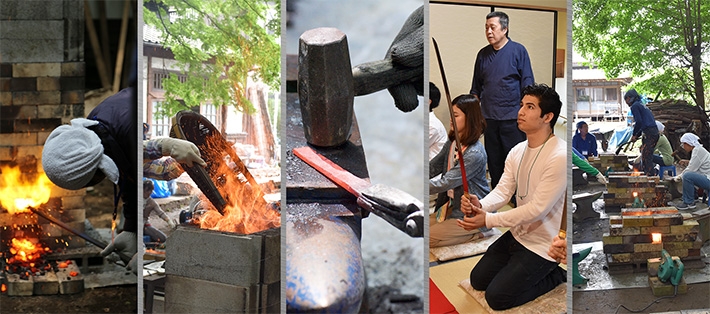
Tokyo Tech has long been distinguished by its contributions to Japanese industrial development, and manufacturing in particular, through its education and research in the fields of science and technology. A fundamental aspect of education and research at the Institute is monotsukuri, the Japanese work ethic and philosophy in which one possesses the spirit or state of mind to manufacture goods of utmost quality and excellence as well as the ability to continue improving the processes thereof.
Appreciating the learning opportunities presented by hands-on experience with traditional manufacturing processes and observation of a master craftsman, Tokyo Tech faculty members began organizing a Tatara Steelmaking Workshop through which science and engineering students from Tokyo Tech and abroad could gather to learn about monotsukuri and develop new perspectives on manufacturing.
Tatara is a traditional process of producing high-grade steel from iron sand and charcoal. Compared with modern steelmaking methods, the tatara process requires considerable time and shows low yield, increasing production costs. Today the process is used almost exclusively for the manufacture of Japanese swords and for passing down tatara techniques. As Japanese steelmaking and swordmaking are closely linked to Japanese religion, spirit of craftsmanship, and traditional technology, tatara is considered one of the signature practices for monotsukuri.
The 2019 Tatara Steelmaking Workshop, organized for the third time by Tokyo Tech, welcomed nine students from the Massachusetts Institute of Technology (MIT) and Harvard University, and 10 students from the Global Scientists and Engineers Course at Tokyo Tech. The workshop attracted a range of students, including those majoring in materials science, as well as those interested in steelmaking, Japanese culture, Japanese swords, and traditional Japanese craftsmanship.
at Tokyo Tech. The workshop attracted a range of students, including those majoring in materials science, as well as those interested in steelmaking, Japanese culture, Japanese swords, and traditional Japanese craftsmanship.
The Learning Begins
Bilingual online lectures convey pre-learning content to local and overseas participants
Due to the volume of content and time constraints, organizers of the 2019 iteration of the workshop collaborated with the Online Education Development Office (OEDO) at Tokyo Tech's Center for Innovative Teaching and Learning (CITL)
at Tokyo Tech's Center for Innovative Teaching and Learning (CITL) to produce a series of online lectures in Japanese and English as pre-learning content for participants. Taught by School of Materials and Chemical Technology Assistant Professor Takashi Watanabe, an expert on metallurgy and iron smelting, the lectures introduced students to tatara steelmaking processes, the differences between Japanese and Western steel, and safety precautions for the workshop.
to produce a series of online lectures in Japanese and English as pre-learning content for participants. Taught by School of Materials and Chemical Technology Assistant Professor Takashi Watanabe, an expert on metallurgy and iron smelting, the lectures introduced students to tatara steelmaking processes, the differences between Japanese and Western steel, and safety precautions for the workshop.
Exploring the depth of traditional steelmaking techniques through hands-on experience
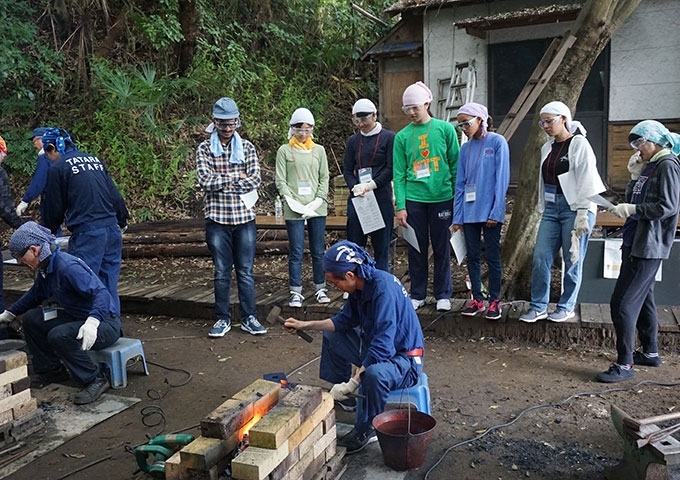
Students observe as Master Swordsmith Matsuda
forges steel
The workshop was held at the studio of one of Japan's foremost swordsmiths, Tsuguyasu Matsuda, in Chiba City, Chiba Prefecture on July 20, 2019. Being able to reproduce traditional Japanese swords of the Kamakura Period (800 years ago) which has been considered as impossible, Matsuda is recognized by Chiba Prefecture as a holder of Important Intangible Cultural Property. Sharing personal anecdotes as he demonstrated sword making techniques, Matsuda led student participants in crafting their own paper knives (letter openers) using steel produced through tatara techniques.
Hands-on Practice in Tatara Steelmaking
- 1.
- Students built the simplified tatara furnace using refractory bricks.
- 2.
- They used an electric blower to preheat the furnace and accelerate charcoal combustion.
- 3.
- When the temperature inside the furnace reached the desired level, they poured iron sand into the furnace. Through charcoal combustion, the iron sand was partially reduced to metallic iron, and the remainder became oxide melt called noro, which looks like lava. As the function of noro is to protect the steel from oxidation during forging, students needed to carefully control the amount and temperature of the noro. Based on the rate of charcoal consumption, the color of light observed in the furnace, and viscosity of noro released through a noro discharge port in the side of the furnace, the students were instructed to make careful adjustments to the amount of air blown into the furnace and the amount of charcoal added.
- 4.
- After all of the iron sand was added to the furnace, and the charcoal was completely combusted, the students deconstructed the furnace and removed the resulting high-grade steel.




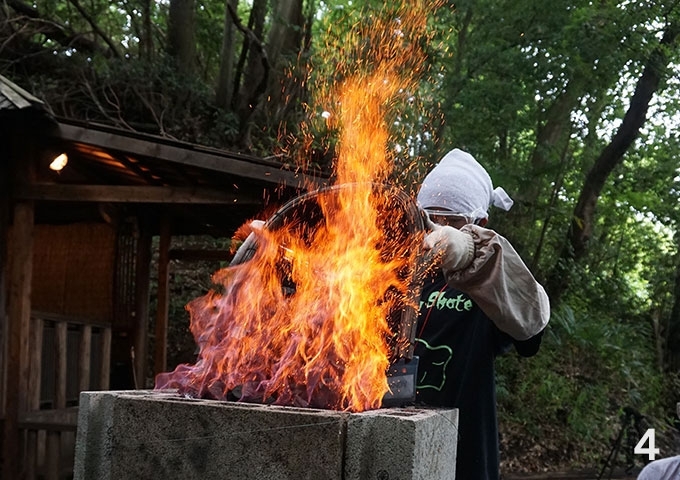
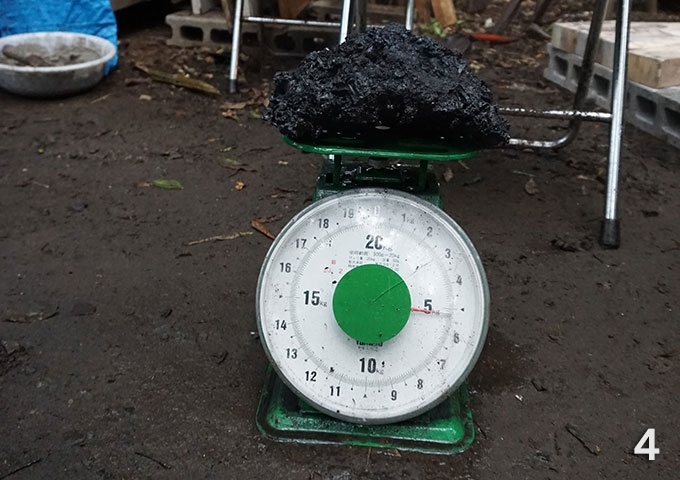
Making Paper Knives
Under Matsuda's supervision, students prepared a forge, heated steel blades, and hammered, shaped, and sanded the blades to make their own paper knives. While the master craftsman wielded his tools with ease, the students struggled to form and shape their paper knives.
The Art and Esthetics of Japanese Swords
Later, Matsuda spoke about the spirituality of Japanese swords and the abstract beauty of the blade patterns created by metal structure through the process of forging and heat treatment. The students appreciated the beauty of the Japanese swords as they held and examined them up close.


Workshop participants enjoying lunch together
Students' Experiences
"A great opportunity to think about the meaning of craftsmanship"
L. L., 3rd-year, Department of Mechanical Engineering, MIT
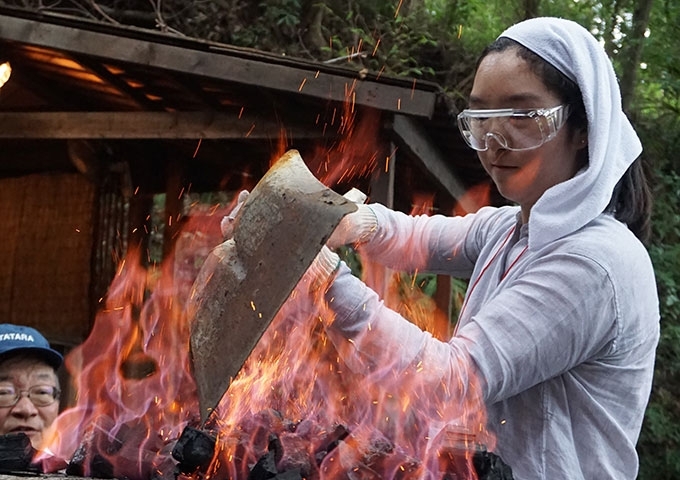
Because of my major, I have had a lot of experience with commercial steel, but this was my first experience with Japanese steel. I had never really considered steelmaking an art, but seeing the process completely personalized and human made me reconsider my thoughts. Through this workshop, I was exposed to a lot more than Japanese traditional culture. I learned what engineering and crafting means to me. It's not just about the technical details and the theoretical calculations but about the beauty of the craftsmanship and the tiny differences between the products. I believe this appreciation of beauty and attention to individual processes is something that will stay with me throughout my career. This tradition should be more widely known and preserved, and I enjoy telling others about it.
"The beauty of monotsukuri is in the optimization of processes"
H. K., 2nd-year, Department of Industrial Engineering and Economics, Tokyo Tech
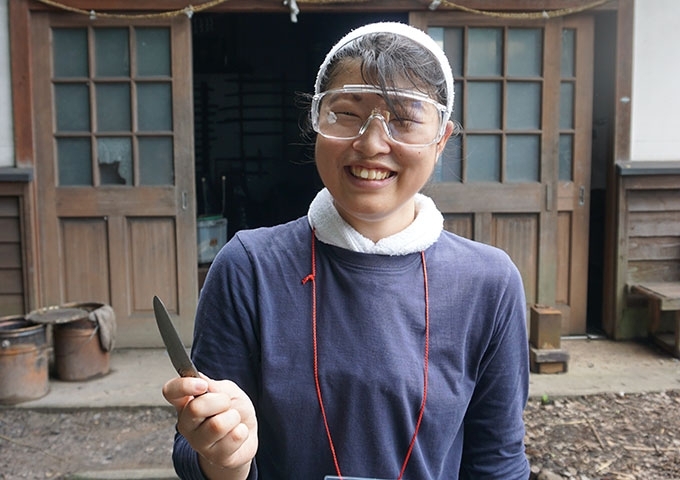
My department, Industrial Engineering and Economics, teaches optimization in production management from a theoretical perspective, so the swordsmith's comment that, "Sometimes we find good methods that we have no theoretical explanation for," left a strong impression on me. Through this workshop, I realized that the optimization of processes over many years is part of the beauty of traditional Japanese manufacturing.
Observing the master swordsmith's delicate temperature adjustments during the forging processes, I felt wonder and pride that Japan still has these highly skilled craftsmen today. I would like to pass these traditions down to the next generation and share the beauty they embody. Interacting with students from Japan and overseas was also fun. I hope to maintain our friendships.
"Sharing traditional Japanese philosophy with students from the United States"
T. T., 2nd-year, Department of Life Science and Technology, Tokyo Tech

The word "tatara" is connected in my mind to the male character who watched a tatara iron works burn down in the Studio Ghibli animated film "Princess Mononoke." The boy's words, "Oh, no, the roof … It's all over… If the Tatara factory is lost, everything is finished," indicate that tatara was advanced technology in, and an important aspect of, ancient Japan.
Advanced technology today often seems far removed from peoples' lives, and I sometimes feel that many people don't understand its importance. I think that is because the traditional spirit of Japanese manufacturing — which placed equal emphasis on what is good for the buyer, the seller (or manufacturer), and society — has not been passed down to today's generation.
One of the great things about this workshop was that we experienced traditional manufacturing techniques while sharing traditional Japanese philosophy with students from the United States. As we students will pioneer the cutting-edge science and technology of the future, it is up to us to pass along the spirit of monotsukuri by developing technologies that we can be proud of, and that are good for everyone.
Organizers Reflect on the Workshop

(from left) Workshop organizers
Mori, Ota, Watanabe, and Kobayashi
Tatara Workshop organizers Specially Appointed Professor Eri Ota of the Center for International Education, Associate Professor Equo Kobayashi of the School of Materials and Chemical Technology, and the course instructor, Professor Takashi Watanabe joined Associate Professor Hideki Mori of CITL to reflect on the workshop. Their discussion has been edited and condensed for clarity.
The Challenges and Pleasures of Monotsukuri
Workshop Aims
Ota: Tatara steelmaking requires lots of preparation, such as cutting 20 kg of charcoal into about five centimeter square blocks and laying bricks to make a furnace. You get dirty and use fire, and it is hard work carrying bricks and equipment. These activities are the complete opposite of modern society's pursuit of efficiency in time, money, and resources. Precisely because we live in a time in which we can easily get anything we want, our aim as organizers was to provide students with the opportunity to gain hands-on experience in the many processes involved in manufacturing and ultimately to appreciate the quality of the item they each produced. We also expected that in learning about the traditional values of craftsmen, students would gain new perspectives on manufacturing.
Watanabe: For the last 40 years, a tatara steelmaking experience has been made available every fall to attendees of the Tokyo Tech festival. Using a simplified tatara furnace originally proposed by a Tokyo Tech faculty member who specialized in tatara research, festival attendees can make Japanese steel, just as in the workshop. Because tatara steelmaking incorporates all of the processes students learn in metallurgical engineering, it is an outstanding way for students and others to experience the pleasures of manufacturing, from the selection of materials to the finishing of the final product.
Make Efficient Use of On-line Materials for Pre-study
Mori: Students from MIT and Harvard come to this workshop all the way from overseas. We wanted to make maximum use of their time for hand-on-experience and discussion which can only be realized at Mr.Matsuda's place on workshop time. Thus we decided to produce a series of online lecture on 1) Utilization of steel and Japanese Traditional Steelmaking "Tatara", 2) Artcraft made by Tamahagane (first-class Japanese steel), 3) History of Steelmaking, 4) Comparions of Modern Steel Making and Traditional "Tatara" Steel Making, and 5) Guide for safely workshop.
All contents are bilingual in Japanese and English. We hope that students appreciate the merit of on-line lecture what they can learn anywhere, anytime.
We used edX as an on-line educational platform, which was established by MIT and Harvard. Currently, universities all over the world have providedMOOC (Massive Open Online Courses) through edX and other MOOC platforms. Tokyo Tech has started MOOCs since 2015.
through edX and other MOOC platforms. Tokyo Tech has started MOOCs since 2015.
Insights to Japanese Culture
Kobayashi: As swords are associated with religious ceremonies, they are strongly connected to Japanese spirituality. The lecture given by swordsmith Matsuda deepened both Japanese and international students' understanding of the spiritual aspects of Japanese culture.
Watching Matsuda demonstrate traditional forging techniques and then trying the techniques themselves, students learned about not only the techniques but also their historical and cultural context. This was something that sci-tech students do not have much exposure to on a day-to-day basis, and I think the experience offered them new insights, not only to manufacturing and but also to Japanese culture and history.
Ota: Japanese students realized that they did not know as much as they thought they knew about Japanese culture. Without understanding the culture of our own country, it is difficult to engage in international exchange. Tokyo Tech students who had participated in this workshop previously possessed a good understanding of the content, and consequently, they provided great support for the participants from the United States.
Importance of Learning Traditional Technology
Watanabe: Steel produced through tatara processes is highly pure, resistant to rusting, and has a high degree of softness and toughness — characteristics that differentiate it from steel made by modern steelmaking methods. Mass-produced steel made in blast furnaces sells for about 80 yen per kilogram while the high-grade steel made in a tatara furnace sells for about 8,000 yen per kilogram. The cost makes it impractical for mass production of products; therefore, it is used pretty much exclusively in the manufacture of Japanese swords, which are high value-added cultural assets. Regrettably, many of the techniques used in Japanese steel making have been lost, and few of the processes have been successfully reproduced. However, this makes tatara steelmaking an extremely interesting topic for materials science research.
Ota: Swordsmith Matsuda told us that it is impossible to make a copy of any Japanese sword. Although he has been engaged in sword making using the knowledge, techniques, and experience he has accumulated over the years, it is still not easy for him to control the outcome of the final heat treatment. Even with his experience, according to Matsuda, the end result requires a "bit of prayer." I learned importance of work based on real experience and felt dignity of craftsmanship bared through reliable techniques.
Final Thoughts
Ota: The experience of traditional manufacturing during the Tatara Steelmaking Workshop was a great chance for students to get a new look at monotsukuri, manufacturing, and Japanese culture. I want to encourage students to experience as much as possible while they have the luxury of time.
Watanabe: I want to create more opportunities for students from fields outside materials science to experience the thrill of making things. I strongly encourage Tokyo Tech students and community members to utilize the Collaboration Center for Design and Manufacturing and other campus facilities. You are sure to gain new insights through the experience!
The Special Topics component of the Tokyo Tech Website shines a spotlight on recent developments in research and education, achievements of its community members, and special events and news from the Institute.
Past features can be viewed in the Special Topics Gallery.
. Any information published on this site will be valid in relation to Science Tokyo.




















